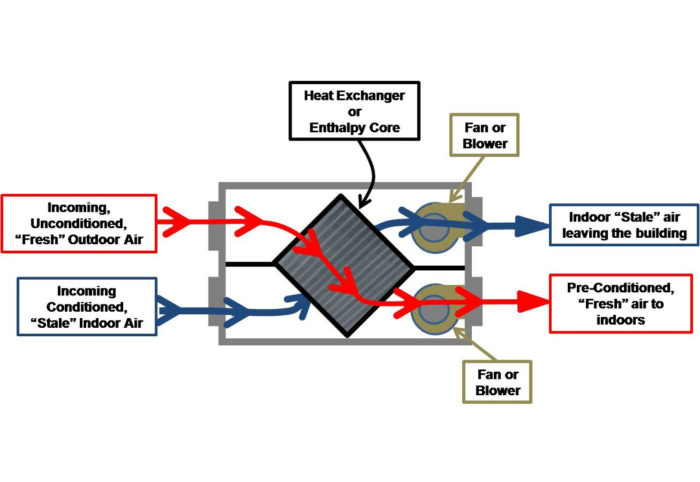The All-Inclusive Overview to the Uses of Heat Recovery Ventilation in Modern Structures
Heat Recovery Ventilation (HRV) systems stand for a substantial development in building modern technology (HRV Heat Recovery Ventilation). They give a technique for exchanging stagnant interior air with fresh exterior air while reducing energy loss. This method not just improves interior air top quality however also adds to energy effectiveness in both property and industrial buildings. Recognizing the numerous applications and advantages of HRV can disclose its vital role in modern style and sustainability initiatives. The ramifications of this technology are worth exploring further
Recognizing Heat Recovery Ventilation Solutions

Numerous contemporary buildings focus on power efficiency, recognizing warm recuperation ventilation (HRV) systems is important for optimizing interior air high quality and decreasing power usage. HRV systems function by transferring warm from stagnant interior air to inbound fresh air, effectively preserving comfortable interior temperatures while decreasing power loss. These systems contain a warm exchanger, followers, and ductwork that assist in the blood circulation of air. Throughout wintertime, HRV devices record and recycle heat from the outgoing air, while in summer season, they can assist cool down incoming air. By constantly exchanging air, HRV systems likewise decrease moisture and the focus of interior contaminants. Correct setup and maintenance of HRV systems are important for their effectiveness and performance in boosting overall structure performance and comfort.
Benefits of Heat Recovery Ventilation
Heat recovery ventilation systems provide many advantages that enhance both energy performance and interior air high quality in modern structures. By capturing and reusing energy from exhaust air, these systems substantially reduce home heating and cooling prices, bring about reduced energy intake. Furthermore, they maintain a constant circulation of fresh outdoor air, decreasing the threat of interior air toxins and allergens. This continuous exchange helps regulate moisture levels, stopping mold development and making sure a healthier living setting. Additionally, HRV systems contribute to sustainability goals by reducing general carbon footprints. Their ability to enhance ventilation without compromising thermal comfort makes them a valuable addition to contemporary structure layout, advertising both economic and ecological benefits.
Applications of HRV in Residential Structures
As homeowners increasingly focus on energy performance and interior air top quality, the applications of warmth healing air flow (HRV) systems in domestic buildings have actually come to be more prevalent. HRV systems are particularly useful in tightly secured homes, where maintaining fresh air blood circulation is crucial for protecting against moisture buildup and indoor pollutants. They properly move warm from outward bound stagnant air to inbound fresh air, reducing power prices connected with heating & cooling. In addition, HRVs can enhance comfort degrees by regulating humidity and temperature. They are likewise versatile for different property designs, consisting of single-family homes and their explanation multi-unit structures. In general, integrating HRV systems supports lasting living practices while making sure a much healthier interior environment for owners.
HRV in Commercial and Industrial Setups
In industrial and industrial setups, the implementation of heat recuperation ventilation (HRV) systems has ended up being significantly vital for optimizing energy effectiveness and keeping air top quality. These systems efficiently move warm from exhaust air to inbound fresh air, minimizing the demand for extra home heating or air conditioning. This not just decreases energy expenses but additionally contributes to sustainability efforts. Industries such as manufacturing, warehousing, and office complex benefit significantly from HRV systems, as they aid regulate temperature level and humidity levels, making certain a comfortable and productive atmosphere. Furthermore, HRV systems help in getting rid of impurities and excess wetness, improving indoor air high quality. As guidelines around air top quality end up being more stringent, the fostering of HRV modern technology is most likely to grow, making it an essential part of contemporary industrial and industrial framework.
Future Trends in Heat Recovery Ventilation Modern Technology

Frequently Asked Inquiries
Exactly How Does Heat Recovery Ventilation Effect Indoor Air High Quality?
Heat recovery ventilation significantly improves interior air high quality by continually exchanging stagnant interior air with fresh outdoor air while recuperating energy. This procedure minimizes pollutants, maintains excellent moisture levels, and guarantees a healthier atmosphere for owners.
Can HRV Solutions Be Set Up in Existing Buildings?
HRV systems can undoubtedly be set up in existing structures. Retrofitting might call for adjustments to ductwork and air flow designs, yet it significantly improves power efficiency and interior air quality, making it a sensible choice for older structures.
What Maintenance Is Required for HRV Equipments?

Are There Particular Climates Where HRV Is Much More Efficient?
Heat recovery ventilation systems are especially reliable in climates with substantial temperature differences in between seasons. These systems maximize power efficiency by recouping warm from exhaust air, making them ideal for both cool and moderately cozy environments.
Exactly How Do HRV Systems Affect Power Expenses?
